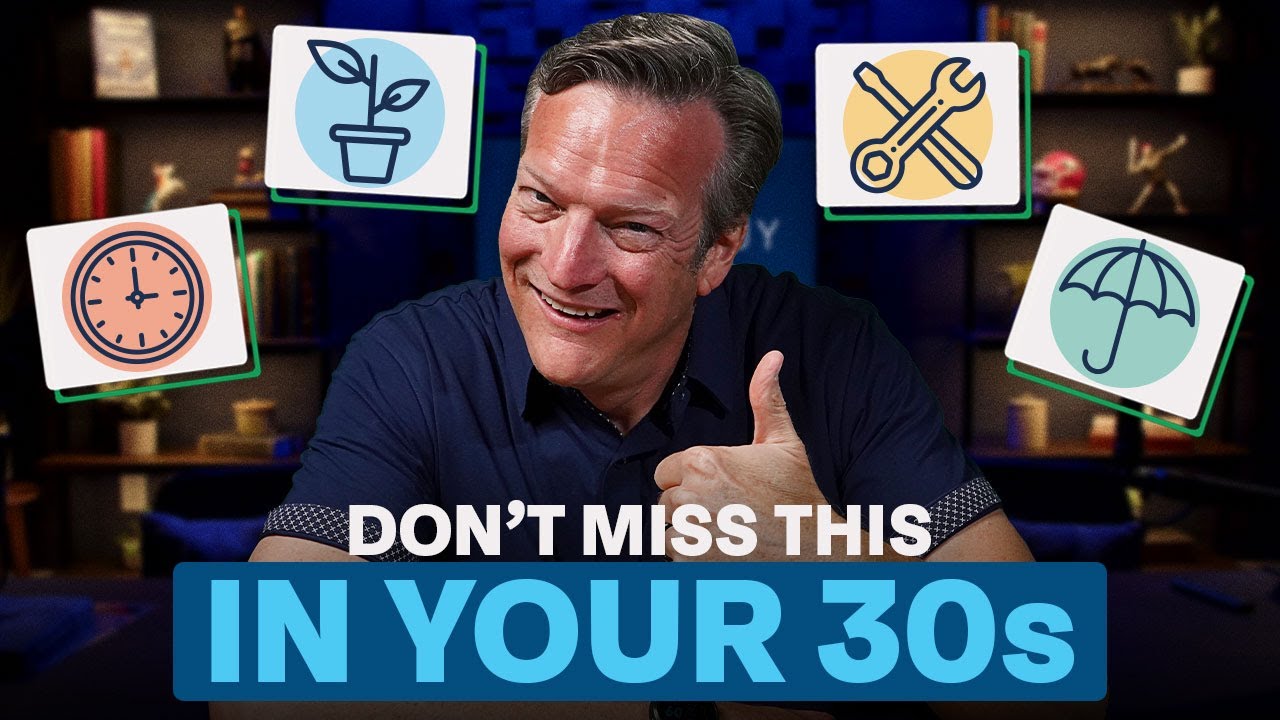So, let's jump right in. Let's start in the 20s and think about your three-bucket strategy. How you ought to be approaching that in your 20s. We think that there is one bucket that you should be so excited about because right now, in this decade, this bucket can be super fuel for your financial wealth-building. Yeah, if you want to get any financial mutant excited and really get them just in a froth, is talk about tax-free growth.
Can you become a tax-free millionaire? Roth accounts make this possible. That's why you're going to start your journey when we talk about the three buckets. Let's prioritize those Roth tax-free growth opportunities. Even if you can't max them out, just start somewhere. For most folks when we get them excited about saving, we say, "Hey, if all you can do is $20 a month, great. Open a Roth IRA. Do $20 a month, $50, $100. It does not matter the number." Why do we love Roth IRAs? Well, one reason is you get to choose the custodian that you use, so you can use providers like Fidelity, Vanguard, or Charles Schwab, with really low expenses and fees if you choose a low-cost provider. Yeah, the other thing I think is great is that the tax-free growth also lends itself to when you get to the distribution phase. It's also tax-free. So, this is going to be one of those things when you see, when we talk about how do you pull your money out in retirement, this is probably the last basket you're gonna pull out of because it's also a great legacy builder as well. So, there's nothing wrong with that tax-free growth opportunity. We also know that if you choose one of those solid low-cost providers like Fidelity, you have a large selection of investments, different than your 401(k) where you have a captive selection of investments. You can go out there and choose which Target Retirement Index Fund, choose which low-cost Index Fund, choose which investment you want to use. So, you get to pick from the entire universe of investments inside of Roth IRAs. Yeah, and we're going to talk about specifically Roth IRAs, your Roth 401(k)s, and other things. You have flexibility in contributions when we talk. You have lots of opportunity. Community these days with the way that the government has set up these different opportunities, you can save for tax-free growth no matter what your income is, no matter where you are in age. This is a great opportunity, especially for those in their 20s who have decades to let that money grow and compound. Now, Roth assets are not the only tax-free assets available to you.
You also have the ability to contribute to a health savings account, assuming that you're in a high-deductible health plan. You have to be covered by a high-deductible plan in order to contribute. But this is yet another area where you can build your tax-free bucket. Yeah, this is part of that dynamic duo of Step number five of the
Financial Order of Operations: that tax-free growth. We love HSAs because they're triple tax-advantaged. What do we mean when we talk about triple tax? We're talking about tax deduction on the contribution, number two, we're talking about assets grow tax-deferred, meaning you don't pay taxes every year as the money goes up or it has income distributions. It's tax-deferred. And then, if you use it for medical purposes, for healthcare, and other things, it is actually distributed completely tax-free.
Now, Bo, there's actually a bonus category we talk about: the triple tax advantage. But here at
Abound Wealth, we've actually taken advantage of the opportunity. What is that fourth bonus chance? If you work with an employer that allows you to do salary deferrals into your HSA, those contributions are not subject to payroll FICA taxes. So, it's another level of tax advantage. If you have the ability to do an HSA and can payroll deduct it, and you're a young person in your 20s, you may really want to put some attention into this strategy because it can be huge for you down the road.
Most 20-year-olds are going to load up on the tax-free stuff, but let's move to the next column or the next bucket. That's the tax-deferred. Now, look, this one probably gonna have a lot of contributions other than getting that free money from your employer because I realize with the new tax legislation, there's a good opportunity that potentially all of your money could be tax-free. But under general rules and the way people typically don't change that fast, probably the lion's share of people, your employer match is still going to go in that tax-deferred bucket.
Now, what that means is that while the money grows every year when your employer puts that matching money or that profit-sharing money into the retirement account, every year as it grows, you're not going to pay taxes. But it's only tax-deferred, not tax-free, because when you do pull it out as a distribution in retirement, you will pay ordinary income taxes on this bucket. And Brian, you already mentioned this. This bucket may not be growing a lot in your 20s, but that's okay. And there's a chance that the reason it's not growing is even if you are doing your 401(k) in your 20s, you're likely in a lower tax bracket. So a Roth 401(k) may be the thing that makes sense for you, which is actually building your tax-free bucket, not your tax-deferred bucket. But again, that's okay.
Alright, Bo, let's talk about the third bucket: the after-tax bucket. This one, I feel like people in their 20s, they get caught up on this one because they want it so bad. But I'm just not positive in your 20s is where you should be focusing on this. Now, remember, we are past emergency reserves. We're focusing this show primarily on step five and beyond for the
Financial Order of Operations. But your after-tax is where your emergency reserves and other things. But we're talking about after-tax for investments, marketable investments like mutual funds, index funds, and so forth. This bucket probably is not getting a lot of attention because there are just so many opportunities on the tax-favored side of things that this is probably the last tier that you're going to be looking at unless you're a way overachiever and you can blow past 25 and you can look here at that point.
Now, in your 20s, what you need to focus on is discipline because it's easy for TikTok and Instagram and YouTube and social media to force us to look in the wrong direction. So, make sure you understand where your guardrails are. Even though opening up that account or trading the options or doing that thing might seem sexy, don't go out of order of the
Financial Order of Operations. You're going to see in our case study that it was built for a reason. So, make sure you're following the
Financial Order of Operations in your 20s because it is supposed to show you how you can maximize your army of dollar bills.
Let's revisit Manny again. I want to remind you of the assumptions. Manny starts investing 25 percent at age 25 and he stays until he's 65. He makes fifty thousand dollars a year, and he gets raises of five percent per year. No other income, no bonuses, nothing like that. He follows the financial order of operations step by step, and he gets an employer match of three percent if he puts six percent into his 401k. So, he starts doing this at age 25. Well, by the time Manny gets to age 29, look at this: his income at 29 has grown now to $60,775. But because he has been diligently saving for that four-year period leading up to age 29, he now has almost $91,000 in his investment portfolio. Yeah, it's kind of amazing that the lion's share of this is tax-free, obviously because he's loading up that Roth IRA, he's doing the 401K, and tax-free contributions as well. It's amazing. Now, look, there's nothing in the after-tax, but it's tax deferred. That's the employer matching money, that free money from the employer. Of the $90,000, or close to $91,000, that is from the employer. And it's really interesting because this is a person that's only been saving and investing well below 10 years. I mean, we're talking four or five years since he waited until 25 to start investing. It's already exceeded almost one and a half times his income, making $60,000 now worth over $90,000. That's pretty incredible how fast money can stack up. I think people are amazed to see this, that just starting out on your journey, just by being a consistent and disciplined saver, you can build to six figures relatively quickly. Another thing we want to show you is Manny is on a path. He's on what we call the journey to abundance. Again, if you have our net worth tool, you're familiar with this, but we want to show you where you are.
Are you an average accumulator of wealth? Are you a prodigious accumulator of wealth? Well, you can see from the time that Manny started at 25 all the way now until 29, he has now surpassed the average accumulator of wealth. He is above average from a savings standpoint, working towards being a prodigious accumulator of wealth. Again, if you're not tracking this, go download the
Net Worth Tool at
learn.moneyguy.com, and you can follow your journey to abundance just like Manny. Yeah, we just took some screenshots from the actual tool. What I find amazing is that I think a lot of us who come from humble beginnings, we get this goal that we want to hit seven figures, we want to be millionaires. But there are so many steps in between that I want you to take the chance to celebrate. Because Manny the mutant, let's face it, he had to first start from zero, get to $50,000, well, truly ten thousand, then get to fifty thousand, at ninety thousand at age twenty-nine, really, really close to crossing into six-figure status. For a hundred thousand, that's gonna be another one that you'll probably pour over ice, whatever your favorite beverage is. These are celebrations. Don't focus on something that seems so big like seven figures. Start with the first ten thousand dollars, start with getting to six figures by a certain age. All these things will start building upon themselves, and you'll see it's easier and easier to go if you can just focus on what small incremental decision you can make today to start the journey.













